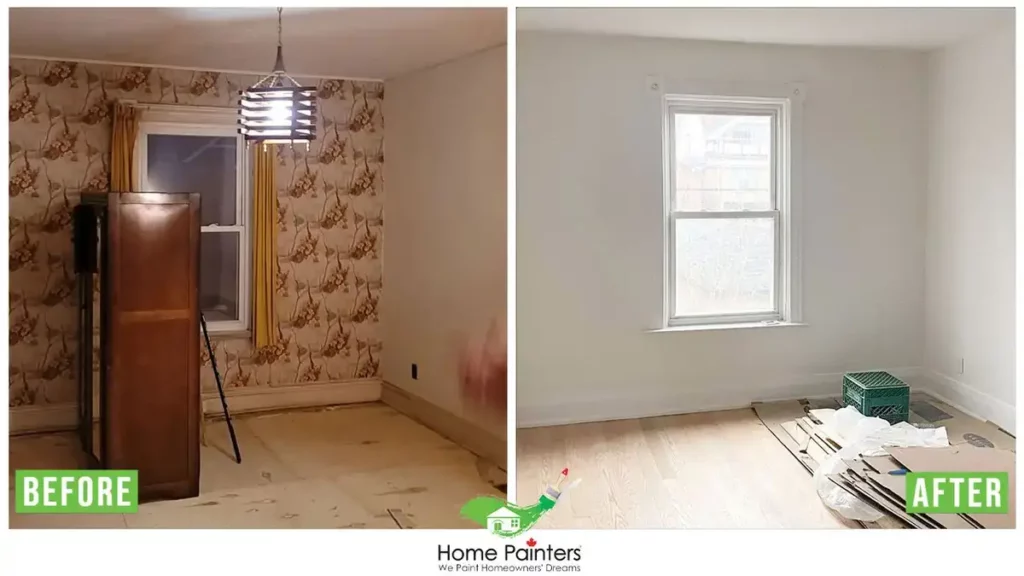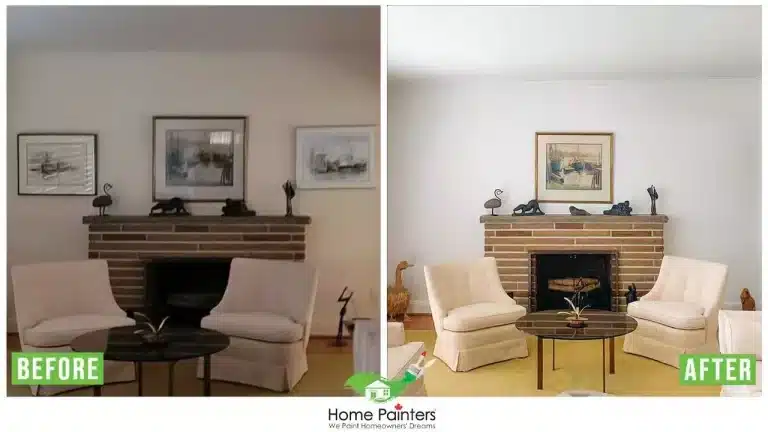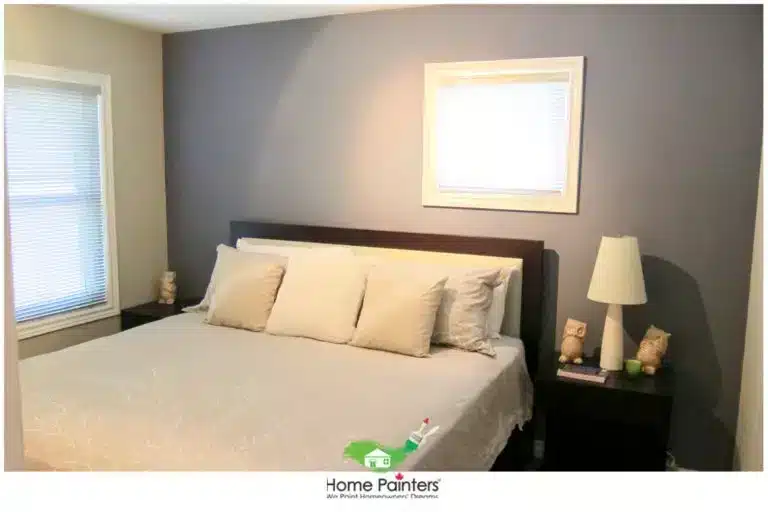
Painting a Wall is a Great Way to Bring a Fresh Feel to Your Home!
It’s a quick, easy way to update the interior of your home. If you have never painted a wall before, it can seem like an intimidating task. But with these painting walls for beginners tips, you’ll be able to do it like a pro!
So, how to paint a wall and room fast like a professional? An 18-in.-wide roller setup like this may not be for everybody. Painters use them for the obvious reason that they can paint twice as fast as they can with a standard 9-in. roller.
If you have a lot of large, unbroken walls and ceilings, the investment in a large paint pail—18 18-in. roller cage, and 18-in. cover makes sense for you, too. You’ll definitely save a bunch of time. Plus, because the roller is supported on both edges instead of just one, it’s easier to apply consistent pressure and avoid roller marks left by paint buildup at the edge of the roller.
How to Paint a Wall Outside
There’s no denying that painting the house’s exterior is a big job. So it’s important to make sure that a big job is done well.
When figuring out how much paint you’ll need, calculate the width and height of the entire house, then remember to subtract the measurements of windows and doors for an accurate final total, so you can get the right quantity of paint. This will vary depending on which product you use.
Here are the Tips on How to Paint a Wall Outside
Tip 1: Wash the Walls
Cleaning your walls is an all-important first step that you don’t want to skip. Make sure your walls are free of any dirt, debris, or stains. Then, remove any surface dirt and any loose or flaking paint by giving the whole surface a good wash down. Make sure you then rinse the wall with clean water to ensure a quality finish that lasts for years.
Tip 2: Repair and Prime
Now that you have a clean base, the next step is to repair any cracks or holes in the render with Polycell Multi Purpose Polyfilla, so you get a perfect finish. Depending on what materials your walls are made of, an excellent exterior house painting tip is to start off with a coat. This is especially important for any shiny or porous surfaces so that your first coat of paint adheres properly to the walls. If you find your masonry surface is powdery or chalky after you’ve prepared it, this water-based primer will seal any unstable areas. Just brush or roll it on, and you’ll be good to go. It’s also suitable for your interior walls, too, which is handy.
Tip 3: Choose a Protective Paint
You’re giving your walls and front-of-house décor protection from weather damage, as well as mould and algae growth. They’re also made with anti-fade technology for long-lasting colour. Two coats are usually enough, but if you’re painting over a strong shade, you might need a third.
How to paint a wall with a roller? Changing up the paint colour of a room is a quick and easy way to completely transform both its look and feel. A paint roller is the best choice when you’re looking to cover large areas, like walls quickly.

Before beginning the painting process
Start by ensuring you and the area are protected. Remove all furniture from the room that you’ll be painting and lay down drop cloths to protect the floor. Open all the doors and windows in the room that you’ll be working in to allow for proper ventilation. Additionally, before you start working, be sure to put on a face mask, and any other personal protective gear that you may want.
Preparing the paint tray is easy
But there’s an important step you need to remember. Thoroughly stir the paint in the bucket before transferring it to the paint tray. Once it’s stirred, pour it into the deep side of the tray, and you’re ready to start painting.
Trimming the frame of the room
Start by trimming the frame of the room by painting a 3- to 4-inch wide perimeter around all of the wall’s edges using a paintbrush. By no means does this part of the paint job have to be perfect, but it’s difficult to paint these areas using a roller without creating paint buildup, so painting this ahead of time with a brush will help you out.
Light and even pressure
With light and even pressure, begin painting, starting about 12 inches inward from the edge of the wall. Rather than starting toward the top or bottom of the wall, start with your roller in the middle of the section, and paint using up and down strokes, rolling the paint on the downstrokes.
Avoid the edges and corners
For now, avoid the edges and corners. After a few up-and-down passes, continue this motion, moving both lefts toward the edge of the wall and right, in the direction of the rest of the wall that needs to be painted.
Final coat
For the final coat, go back to the edge of the wall that you started at. Starting at the bottom of the wall, roll up to the top, then back down over what you just painted.
Every time you get back to the bottom, lift the roller off the wall, then move to the next section. Each new stroke should overlap the previous one, as this will help to smooth the finish.
Colours have a pivotal role in our lives. We gravitate towards a colour from choosing our clothing to the colour of the car we drive to choosing the paint colours of our dream home. We express ourselves through colour. So, it is fine to be demanding and particular in choosing your interior wall paint colour.
The paint colours you choose revamp the look of your home. Colour can make or break a space depending on the combinations you prefer. The colour combination you choose for interior walls has a profound influence on your family, and many people tend to make mistakes while choosing colour combinations.

Pastel colours
Pink, mauve, and baby blue lacking strong shade are called pastel colours. The pastel colours blend well together. Using pastel colours in your interior wall paint will give a distinct look and feel to your home. These colours flaunt a soft, neutral, and soothing nature in your home. It is the best home painting colour combination for your children’s room.
Purple and Gunmetal Grey
Purple mixed with grey makes your home’s interior look more dignified and sophisticated. The outward nature of purple, rightly blended with a neutral grey will come across as a distinguished wall paint colour combination. This combination in your living room, speaks volumes about your exquisite taste. This colour combination will be a new trend that everyone will love.
Soft Pink and Turquoise
Soft pink and turquoise shades are a bold colour combination for your home’s interiors. The combination lends a bright and lustrous look to your home, and the exuberant nature of pink and turquoise makes it a good choice for your daughter’s room. It is one of the versatile colour combinations for walls, as it works well with a number of design styles in your home interiors.
Aquarium Blue and Grape
This unique colour combination on your interior walls infuses vibrant and playful energy. These colours surround you with a joyful and enthusiastic vibe that can change the nature of a dull room. This colour illuminates even a lightless space in your home. This playful and bright colour combination in your home entrance makes it appealing to your visitors. Aqua and grape are one of the best colour combinations for your home.
Blue and Yellow
Blue and yellow make an electric pairing. The mix of vivid blue and warm yellow makes your interiors look more exciting, and dynamic. Dramatic blue walls get a splash of contrast from the yellow and mellow mood of your home. This dynamic combination is most suited for your study room, as yellow enhances memory. The impact these colours can create in your home makes them the most preferred interior wall paints.
Orange with White
Orange is the colour of laughter and celebration. When mixed with white, it creates the perfect ambience for a happy family. Orange dominates the scheme and unifies several spaces in your home. The purity of white and the cheerfulness of orange in your bedroom make it the best choice for your bedroom. This is one of the fascinating interior wall paint colour combinations.
Navy blue and White
With blue taking centre stage and accents of white, this colour combination is the most minimalistic interior wall paint colour combination. This colour combination adds a lot of perspective to your home, and it makes your interiors look clean and elegant. This combination also makes your room look spacious and stimulates your appetite, making it the obvious choice for your kitchen.
Grey on Grey
Although a monochrome palette, Shades of grey builds texture in your home. Grey being a neutral colour will give a pleasant and placid feel to your interiors. The shades of grey in your interior walls add a classy and majestic look to your home. This makes grey the best two-colour combination for bedroom walls.
Cream and Aqua
The combination of aqua and cream spread a cool and breezy mood in your home. The combination reminds the people in the room of the beach, with aqua reflecting the sea and the dull cream representing the sand. This combination of your interior walls will create a relaxed and peaceful ambience. So, this is a go-to interior wall colour combination for beach houses and guesthouses.
Brown and Green
We always tend to feel calm and collected while sitting in a park. It is the trees that ease our mood, making us feel fresh and calm. The same can be applied to the combination of earthy brown and green in your interior walls. This combination makes you feel fresh, and append a natural ambience to your home. We would love to know which of the above combination you would like to have in your interiors.
How Do Professional Painters Paint Walls?
At Home Painters Toronto, we love to do the work for you, but we also like to offer up our top tips for painting basics!
Painting may seem fairly simple in principle. You might think all that is involved is taking a paintbrush, slapping some paint on the wall, and letting it dry. Who needs a professional painter anyway? The answer is, YOU do! Yes, anyone can paint a wall. But there is more to a professional interior painting project than simply applying paint to a wall. To start with, you need to prepare for painting. And we’re here to help guide you through all of that. Let’s dig into some painting basics for painting a wall!
Step 1: Painting Basics – Prepare Your Room for Wall Painting
Preparing to paint:
- Remove furniture from the room
- Protect floors with a drop sheet
- Gather necessary tools
- Wear protective clothing
Step 2: “Cutting In”
This process is how professional Toronto painters begin painting. What does “cutting in” mean anyway? Basically, it’s just a professional painter’s way of saying “painting along the corners and trimming carefully with a small brush”. It simply prevents any messes on your trims and makes the lines where the paint ends crisp and tidy.
“Cutting in” is one of the most important steps in painting a room. If you’re looking to really take in the painting basics about “cutting in”, visit this blog for all of the details!
Step 3: Painting Basics – Painting the Wall
While you can use a paintbrush to paint a wall, painting contractors typically will use a roller brush because it allows for quicker, neater work. You’ll avoid seeing brush strokes or any missed spots.
To paint a wall with a roller, be sure to have the proper materials to get the job done right the first time. Make sure you have a new roller and an extender for reaching higher parts of the wall or ceilings. You’ll also need a paint tray and paint that is the correct colour to match the “cutting in” that you did earlier.
Pro Painter Tip for Interior Painting
Interior Wall Painting Techniques – Use a “W” shape when using a roller because it will help you to fill the space in faster and also helps to prevent any harsh, visible brush strokes.
It is preferable to use less paint than more, as this will result in a big mess.
Try out these interior painting tips on a wall in your Toronto home and check out our Pinterest page for more interior painting tips from a professional painting company.

More Interesting Blogs Related to
“DIY Painting Basics: How To Paint A Wall”
If you have an idea you would like to try, but do not know how to make it happen, Home Painters Toronto can help. With 35 years of experience as professional painters, let our experience do the heavy lifting.
Please call us NOW at 416.494.9095, or email us at [email protected] to get a quote for your interior painting project. And don’t forget to follow us on all our social channels below as well!





